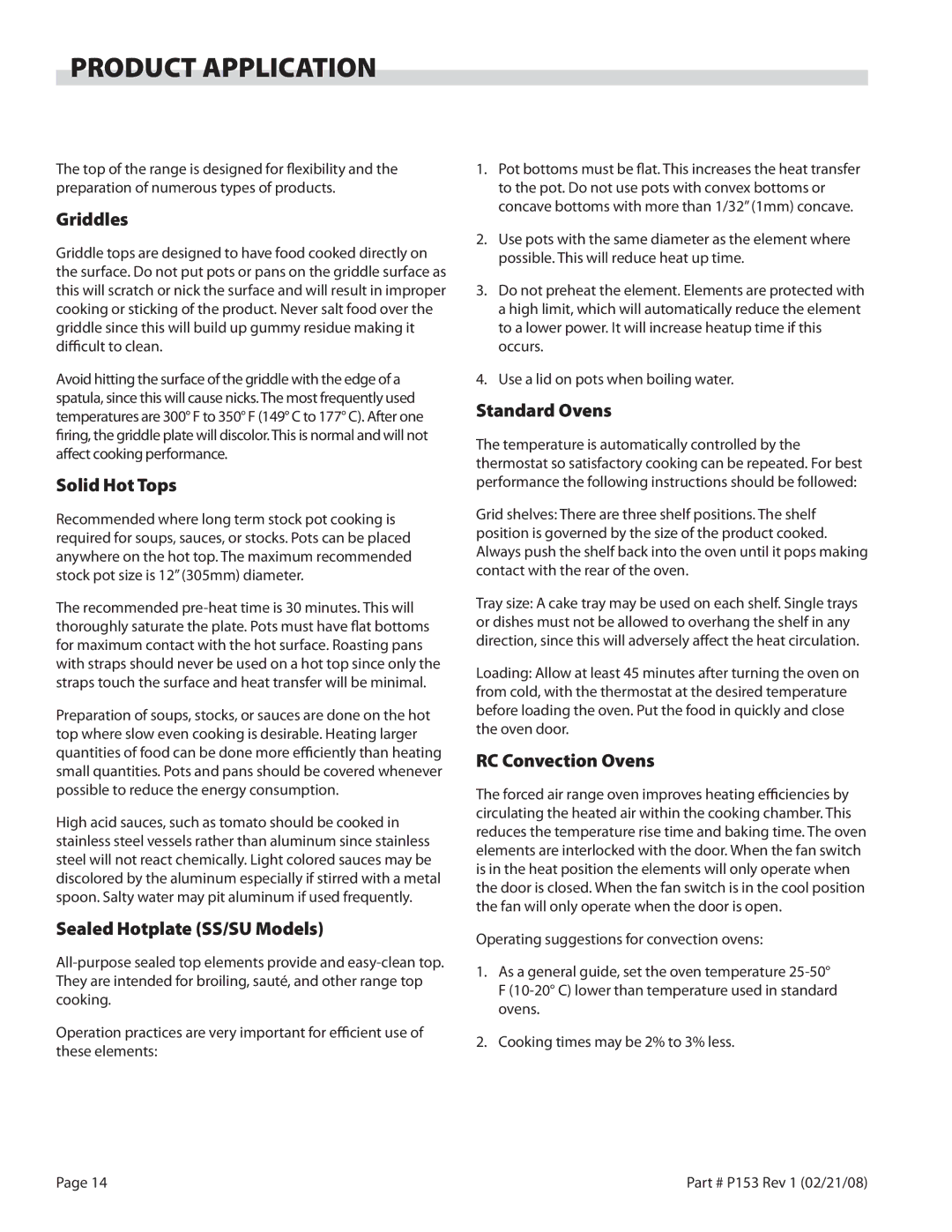PRODUCT APPLICATION
The top of the range is designed for flexibility and the preparation of numerous types of products..
Griddles
Griddle tops are designed to have food cooked directly on the surface.. Do not put pots or pans on the griddle surface as this will scratch or nick the surface and will result in improper cooking or sticking of the product.. Never salt food over the griddle since this will build up gummy residue making it difficult to clean..
Avoid hitting the surface of the griddle with the edge of a spatula, since this will cause nicks.. The most frequently used temperatures are 300° F to 350° F (149° C to 177° C).. After one firing, the griddle plate will discolor.. This is normal and will not affect cooking performance..
Solid Hot Tops
Recommended where long term stock pot cooking is required for soups, sauces, or stocks.. Pots can be placed anywhere on the hot top.. The maximum recommended stock pot size is 12” (305mm) diameter..
The recommended
Preparation of soups, stocks, or sauces are done on the hot top where slow even cooking is desirable.. Heating larger quantities of food can be done more efficiently than heating small quantities.. Pots and pans should be covered whenever possible to reduce the energy consumption..
High acid sauces, such as tomato should be cooked in stainless steel vessels rather than aluminum since stainless steel will not react chemically.. Light colored sauces may be discolored by the aluminum especially if stirred with a metal spoon.. Salty water may pit aluminum if used frequently..
Sealed Hotplate (SS/SU Models)
Operation practices are very important for efficient use of these elements:
1.Pot bottoms must be flat.. This increases the heat transfer to the pot.. Do not use pots with convex bottoms or concave bottoms with more than 1/32” (1mm) concave..
2.Use pots with the same diameter as the element where possible.. This will reduce heat up time..
3.Do not preheat the element.. Elements are protected with a high limit, which will automatically reduce the element to a lower power.. It will increase heatup time if this occurs..
4.Use a lid on pots when boiling water..
Standard Ovens
The temperature is automatically controlled by the thermostat so satisfactory cooking can be repeated.. For best performance the following instructions should be followed:
Grid shelves: There are three shelf positions.. The shelf position is governed by the size of the product cooked.. Always push the shelf back into the oven until it pops making contact with the rear of the oven..
Tray size: A cake tray may be used on each shelf.. Single trays or dishes must not be allowed to overhang the shelf in any direction, since this will adversely affect the heat circulation..
Loading: Allow at least 45 minutes after turning the oven on from cold, with the thermostat at the desired temperature before loading the oven.. Put the food in quickly and close the oven door..
RC Convection Ovens
The forced air range oven improves heating efficiencies by circulating the heated air within the cooking chamber.. This reduces the temperature rise time and baking time.. The oven elements are interlocked with the door.. When the fan switch is in the heat position the elements will only operate when the door is closed.. When the fan switch is in the cool position the fan will only operate when the door is open..
Operating suggestions for convection ovens:
1.As a general guide, set the oven temperature
2.Cooking times may be 2% to 3% less..
Page 14 | Part # P153 Rev 1 (02/21/08) |
